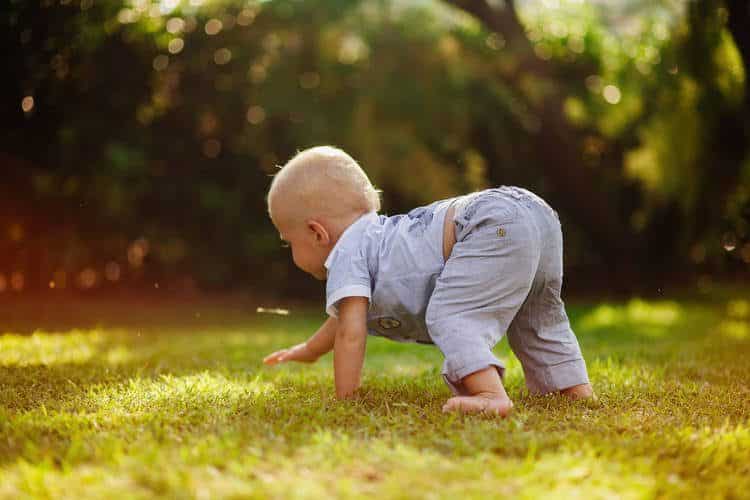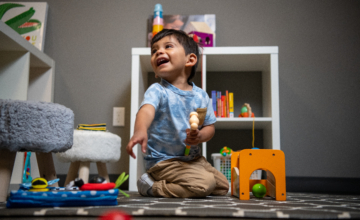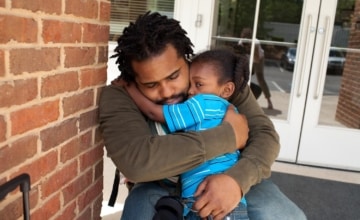Crawling, cruising, walking, running. Once a baby is up and moving, they are a force to be reckoned with. Here’s how to balance your dual role as safety officer and fellow explorer.
Welcome to the world of exploration, where your child gets better and better at getting where they want to go, and you get better and better at keeping up.
Here’s what to expect for baby movement milestones. Remember that milestones predict the order of developing skills rather than an exact timetable. Talk to your pediatrician if you have concerns about your child’s progress.
Rolling Over
Your baby gets ready: Babies spend a lot of time on their backs, sleeping or confined in car seats and carriers. To develop the muscles they need to crawl and stand, they need to spend time on their tummies each day. Read more about how and when to start tummy time.
What it looks like: Rolling over usually starts with tummy to back, followed by back to tummy. When they’re on their tummies, you’ll start to see them putting weight on their forearms and later, hands as they start building the skills for crawling.
When do babies roll over? Between 4 and 6 months
Babyproof: To prevent falls, keep a hand on babies while they’re on beds, sofas, and changing tables.
Crawling
Your baby gets ready: You may see your baby on all fours, rocking back and forth. Or, you may see them crawl backward when they really want to crawl forward. This is all part of learning how to move their bodies in order to crawl.
What it looks like: Babies have different styles of crawling—from classic to commando (lying flat on their bellies and dragging themselves forward). Some babies—about 7%—skip crawling altogether.
When do babies crawl? Second half of their first year (6+ months)
Babyproof: Get down on the floor to see a baby’s-eye view. Cover electrical outlets and remove electrical cords from baby’s reach. Put baby gates at the top and bottom of the stairs. Install toilet seat locks. Pad anything with sharp edges. Move houseplants, fragile items, and poisonous household cleaners out of reach. Baby’s on the move!
What to avoid:
- Baby walkers. They can be dangerous. And it’s much better for your baby to be on the floor where they can practice crawling.
- Lots of time in baby seats and carriers. Babies need plenty of time to play, move, and explore.
Read more here.
Pulling Up/Cruising
Your baby gets ready: You may see your baby begin to pull up to a standing position, or walk with assistance (like holding your hands). You can encourage pulling up by putting an interesting toy on the couch for them to find when they stand.
What it looks like: Your baby will use furniture to pull themselves upright, then walk by holding on for balance.
When do babies pull up? 9 to 12 months
Babyproof: Everything you did at the crawling stage, plus look for hazards that may have been previously out of reach, like the cords on blinds. If you’ve not done so already, now is the time to pad furniture with sharp corners and remove anything that might tip over if your baby grabs or pulls on it. Also: make sure that bookshelves and other furniture that might be toppled by a cruising or climbing baby are anchored to the wall.
Want to see what cruising looks like? Check out the Center for Disease Control (CDC)’s video of cruising, found under the Movement/Physical Development tab.
Walking
Your baby gets ready: Your baby may stand, unassisted, and then sit/fall to their bottoms after a second or two. They may take a shaky step and then fall again. Usually it takes 4–6 weeks of early steps before a baby becomes a confident walker.
What it looks like: You know: One minute they’re gripping your hand and the next minute they’re taking a few wobbly steps, all by themselves. Often when babies take their first steps, their arms are held out by their sides—this is to help them balance. As they get more comfortable with walking, their arms will come down next to their bodies.
When do babies walk? 12 months to 18 months
Babyproof: Again. Higher and farther.
Expect: A lot of practice to get good at walking.
- Falls. One study found that toddlers between 12 and 19 months old fell 17 times an hour. New walkers fell 69 times an hour! This is why you padded all the sharp corners of the furniture the moment they started pulling themselves up.
- Exhaustion—yours and theirs. A busy toddler will take more than 9,000 steps and travel the distance of more than 29 football fields—every day. All this new activity may make it harder for them to go to sleep at night. This is common when children are mastering a new skill. Don’t be surprised if you’re exhausted, too!
Take a peek at this video of walking from the CDC, found under the Movement/Physical Development tab.
Watching your child take their first steps is one of the many powerful moments of parenthood, as your child begins to explore the world with you at their back. Remember that you will always be their touchstone, and they’ll keep coming back to check in and make sure all’s well.




